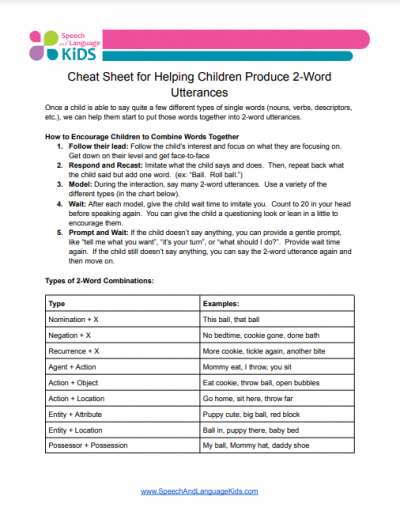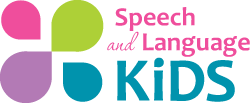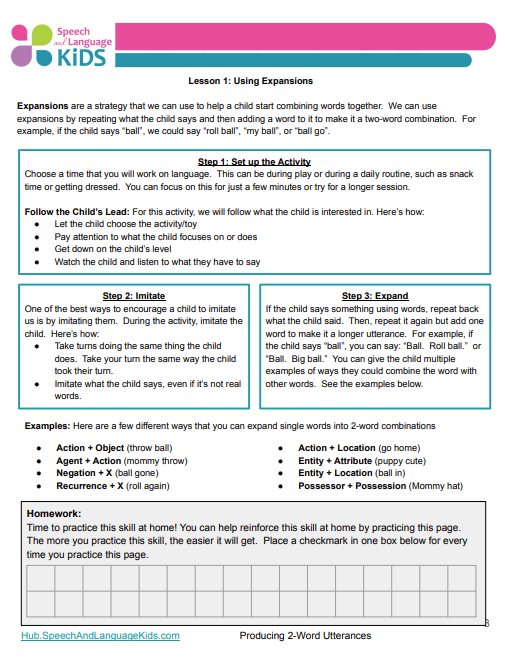When should children start saying two words together? (And how to help them do it)
Did you know there are two different ways that children learn to speak?
Some children learn words one at a time. They will say single words (like “mama” or “up”) until they have enough that they can start combining them together to form 2-word utterances (like “mama up!”). This is called “Analytic Language Acquisition” (ALA).
Other children learn words in chunks. They may repeat back an entire line from a show that they’ve heard (like, “whoa, take a look at that one!”) or repeat back something they’ve heard other people say to them (like, “are you ok?”). Even though these children are just repeating others, they are still using these sentences or phrases to communicate with us. Eventually, they will learn to make their own sentences as well. This is called “Natural Language Acquisition” (NLA).
Today we will be talking about the children who learn words one at a time first. (More on NLA later!)
When Should a Child Start Putting Two Words Together?
If a child is learning words one at a time, then eventually we will see them combine those words together into two-word utterances.
In order for children to start putting two words together, they need to know a variety of words (not just all nouns). They also need to be able to use those words functionally. This shows us that they understand what the words mean.
All of this usually happens by 2 years of age. But some children may need a bit of help to get going with this.
How to Help a Child Put 2 Words Together:
The way we talk to a child can influence how they learn to speak.
Throughout the day, we can model 2-word combinations for the child so they understand how to use those combinations themselves. Here’s how we do this:
Model: Use Many 2-Word Combinations when Speaking to the Child
It is important that the child hears many different ways to combine words together. While interacting with the child, say a lot of two word combinations. Here are some the most common ways to combine early words together:
-
-
-
Nomination (this ball, that hat) + X
-
Negation (no doggie, cookie gone) + X
-
Recurrence (tickle again, more crackers) + X
-
Agent + Action (mommy eat)
-
Action + Object (eat cookie)
-
Action + Location (go home)
-
Entity + Attribute (puppy cute)
-
Entity + Location (ball in)
-
Possessor + Possession (my ball)
-
-
Repeat and Recast: Repeat What the Child Says but Add One Word
When the child says one word, we can repeat that word back to them but add one word. For example, if the child says “ball”, we can say “throw ball” or “my ball”.
Repeat back what the child says and always add one word. Use the word combination types above to come up with different ways to combine words together.
Prompt: Provide Gentle Prompts to Speak
Find ways to prompt the child to speak. You can so this by modeling a two-word utterance and waiting. If they don’t say the 2-word utterance, you can use gentle prompts like…
-
-
- “What do you want?”
- “It’s your turn”
- “Where should I put it?”
- Use gestures, such as pointing to something
-
Strategy Demonstration for Prompting 2-Word Utterances:
Now let’s put it all together. We can help a child put two word together by following this sequence:
- Model: Say a two-word combo that you want the child to imitate.
- Wait: After each model, give the child wait time to imitate you. Count to 10 in your head before speaking again. You can give the child a questioning look or lean in a little to encourage them.
- Prompt: If the child doesn’t say anything, you can provide a gentle prompt, like “what should I do?”
- Wait: Provide wait time again. If the child still doesn’t say anything, you can say the 2-word utterance again and then move on.
Let’s see how this looks:
Download the Free Cheat Sheet for 2-Word Utterances:
Print out this handy cheat sheet and post it nearby so you can remember the types of 2-word utterances to model for a child:

Download this Cheat Sheet for Free Here:

About the Author: Carrie Clark, MA CCC-SLP
Hi, I’m Carrie! I’m a speech-language pathologist from Columbia, Missouri, USA. I’ve worked with children and teenagers of all ages in schools, preschools, and even my own private practice. I love digging through the research on speech and language topics and breaking it down into step-by-step plans for my followers. I graduated from Truman State University in Kirksville, MO with a masters degree in Communication Disorders.
Connect with Me:







Couldn’t print out the Cheat Sheet for Helping children Produce 2-Word Utterances. tried to copy and paste. , but it is too small to read. Is this available somewhere else other than this email?
Hi, BJ-We have emailed you a copy of this resource. Please let us know if you need anything else.
Thank you for offering these!
You are very welcome, Janice! Please let us know if you have any questions.
Hi, I was trying to download the cheat sheet but couldn’t get it and couldn’t click in the “box” that it kept mentioning. Any thoughts about that?
Thank you!
Hi, Mikki-Please check your inbox when you get a chance, as we have emailed you a copy of the requested resource.
How can caregivers assist children who learn words one at a time in transitioning to forming two-word utterances?
Modeling! Spend time saying two-word combinations around the child. When we show them different ways to combine two words together, they are more likely to be able to imitate us and start making their own.